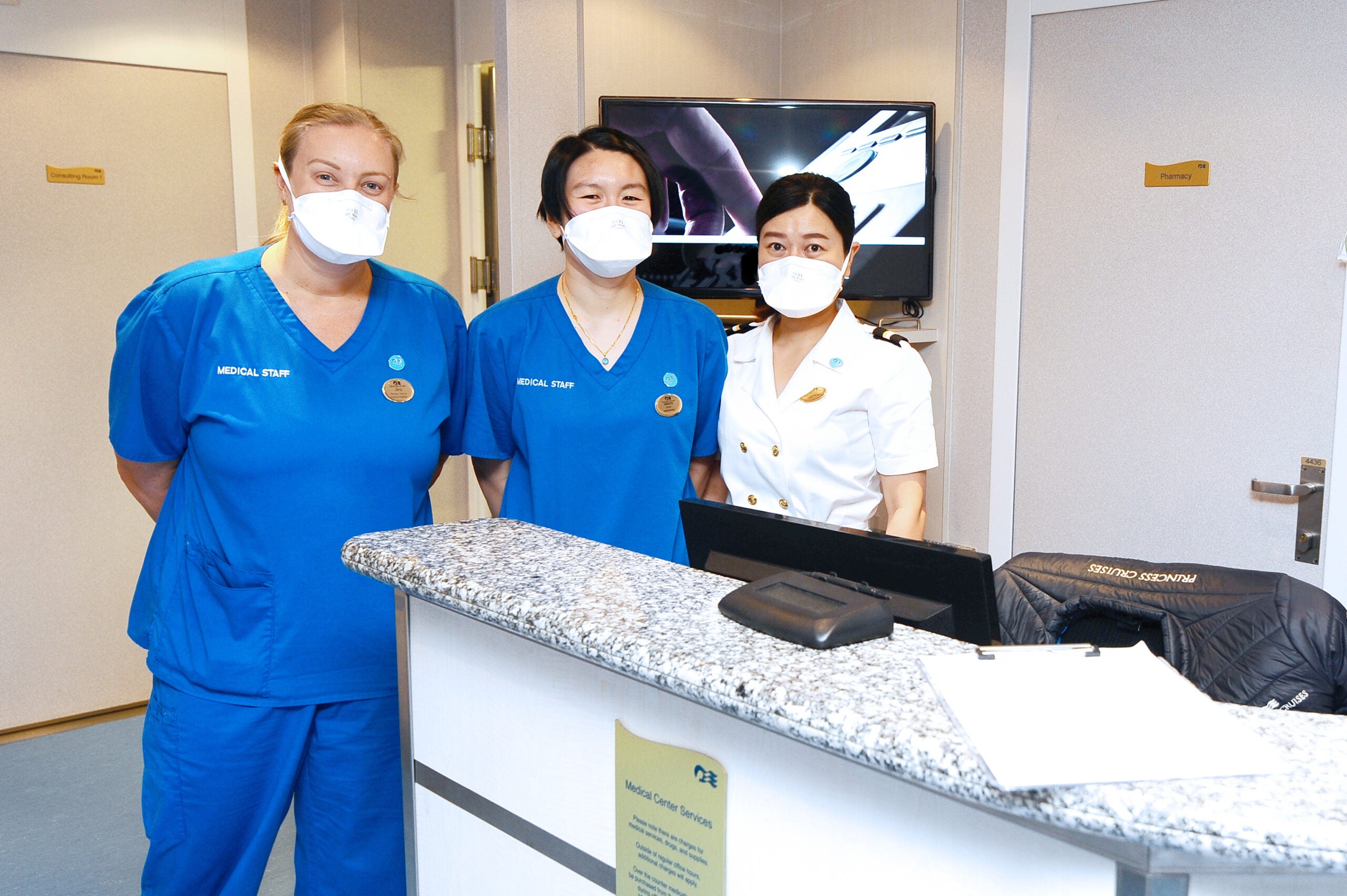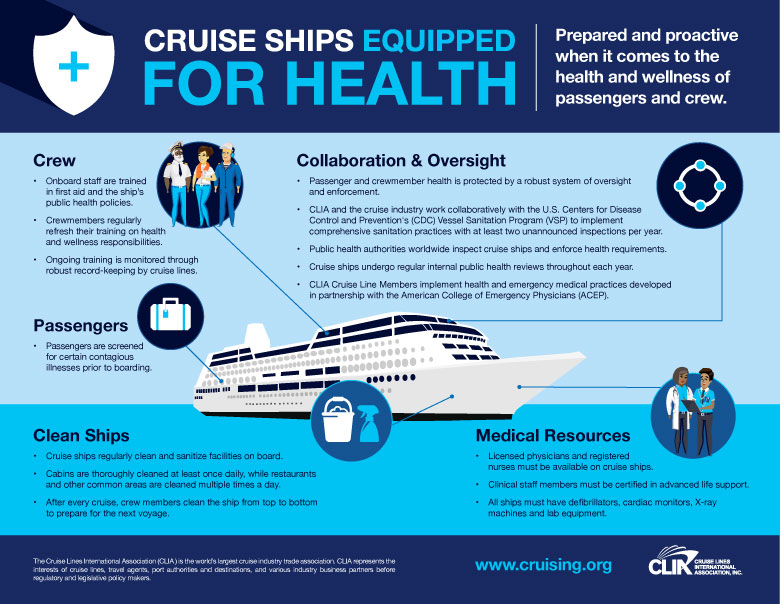Health care guidelines for cruise ship medical facilities ensure passenger safety and effective medical response. These regulations dictate equipment, staffing, and procedural standards aboard.
Heading out to sea for vacation can be thrilling, but passenger health and safety remain paramount. Cruise ship medical facilities play a critical role in this, obligated to adhere to rigorous health care guidelines. These standards are essential for addressing medical emergencies, providing routine care, and ensuring the wellbeing of everyone onboard.
Equipped with appropriate medical supplies and staffed by qualified healthcare professionals, these facilities must be ready to handle a diverse range of health issues. From managing seasickness to responding to critical conditions, maintaining a well-operating medical center is not just about compliance with regulations; it’s about safeguarding the cruise experience for all passengers.
Quick Navigation
Health Risks At Sea: Preparing Medical Facilities
Cruise ships often face unique health issues. Passengers and crew may experience sea sickness, infections, and foodborne illnesses. Sunburn and dehydration are also common due to the environment. It is crucial for medical facilities onboard to be well-equipped and prepared.
Adequate response capacity is essential for handling emergencies. Cruise ship medical facilities must have the ability to treat serious conditions. This includes heart attacks, strokes, and injuries from slips or falls. They should also be ready for potential rescue operations at sea.
Designing Medical Centers On Cruise Ships
Designing medical centers on cruise ships demands specific facility structure and size parameters. The centers should accommodate essential equipment and supplies efficiently. They must be accessible to all passengers and crew.
Key considerations include the incorporation of state-of-the-art medical devices. These are necessary to handle emergencies. The layout ensures easy navigation in urgent situations. Provisions for disability access are crucial for a comprehensive design.
| Area | Equipment | Accessibility Feature |
|---|---|---|
| Emergency Room | Defibrillators, Ventilators | Wide Doors |
| Pharmacy | Medication, IV supplies | Ramps |
| Examination Room | Diagnostic Tools | Signage in Braille |
Staffing For Health: Medical Personnel Requirements
Qualified medical staff are pivotal on cruise ships. The medical personnel must hold valid credentials. This includes licenses and certifications. They should undergo special training. This training ensures they manage onboard health issues. Courses in cardiac care and trauma management are essential.
Each ship has a staffing ratio guideline. It matches the number of passengers and crew. A minimum number of medical personnel is always onboard. This team must be available 24/7. They work on a well-planned on-call schedule. This ensures quick response during emergencies. The focus is always on provided top-notch medical care to all.
Healthcare Protocols At Sea
Healthcare Protocols at Sea ensure safety for all on board. Routine and preventative care procedures are essential. Medical teams do regular health checks. They keep an eye on crew and passengers. Vaccines and screenings help stop diseases before they start.
Keeping everyone safe from germs is key. Infection control measures are strict. Crews clean the ship often. They use strong germ killers. Hand washing stations are everywhere. Outbreak management plans are ready to go. Teams know exactly what to do if illness strikes.
| Area | Protocol | Frequency |
|---|---|---|
| Medical Check-up | Health assessment | Daily |
| Sanitization | Use of disinfectants | Multiple times a day |
| Illness Monitoring | Symptom checks | As needed |
Collaboration With Port Health Authorities
Cruise ship medical facilities must adhere to both legal and regulatory requirements. Collaboration with port health authorities is crucial. This ensures consistency with health standards.
Medical teams should secure agreements with local ports. This helps in managing patient transfers and care after disembarkation. It’s important to have clear protocols for continuing treatment beyond the cruise.
- Maintain up-to-date knowledge of regulations.
- Communicate effectively with port authorities.
- Ensure seamless care transitions for patients.

Cruise Health Technology And Record Keeping
Cruise ships now use advanced health technology. They keep medical records safe and private. Doctors on ships can talk to experts on land. This is called telemedicine. It helps patients get good care when at sea.
Medical records are electronic to protect privacy. Only some staff can see them. The system tracks who looks at a record. This keeps patient information safe.
With telemedicine, doctors have remote support. Specialists can help, even when far away. Patients get quick help during emergencies. This technology is very helpful at sea.

Frequently Asked Questions
What Are Cruise Ship Medical Facility Standards?
Cruise ships must meet the American College of Emergency Physicians’ health care guidelines. These standards ensure adequate medical care for passengers and crew during voyages.
How Do Cruise Medical Facilities Handle Emergencies?
Cruise ship medical facilities are equipped to manage common emergencies. They have trained personnel, emergency kits, defibrillators, and medications to provide immediate care.
Are Cruise Ship Doctors Certified?
Yes, physicians on cruise ships are typically certified and experienced. Their qualifications are in line with international maritime health care regulations to ensure passenger safety.
What Medical Services Do Cruise Ships Offer?
Cruise ships offer a range of medical services, including consultations, treatment for minor injuries, and medications. More severe cases may require evacuation to a land-based hospital.
Conclusion
Navigating the high seas needn’t compromise health care quality. Efficient medical protocol aboard cruise ships ensures passenger safety and well-being. As you plan your sea adventure, rest easy knowing these stringent guidelines are your safeguard.
Embrace the journey, confident in the knowledge that health care at sea is steadfast and thorough.
